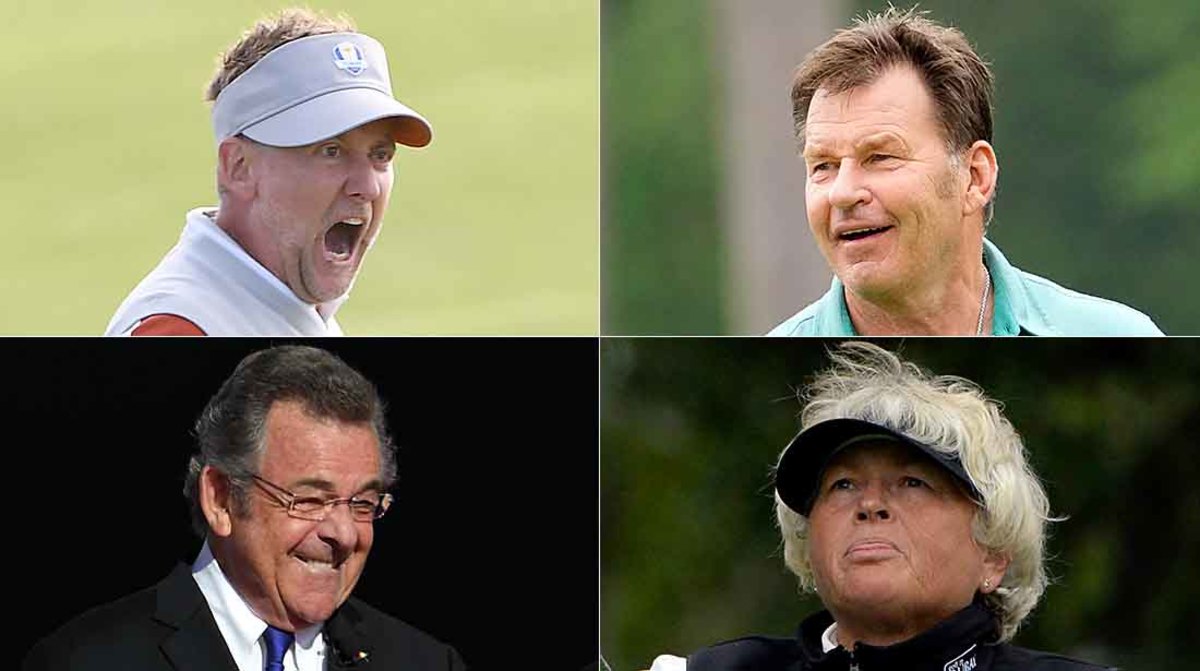Nick Faldo, Ian Poulter, Laura Davies and a King: Ranking Golf's Best From England

Good night, Queen Elizabeth II. Rest in peace after your 70-year reign.
The Queen reigned longer than most blokes and birds have been alive. Blimey, mate. In the seven decades she served, golf has gone from stymies and niblicks to launch monitors, metal woods (not an oxymoron) and titanium drivers that cost $700. The non-golf world also changed slightly during the period (although it would’ve gone down easier if we’d known to buy Microsoft stock when it went public in the mid-1980s, not that we’re bitter).
In honor of Her Majesty’s historic passing, The Ranking takes a look at the English men and women who had the most impact upon golf. The rankings were devised using historical records, binary data spools, newspaper accounts and a slide rule left in the chem lab that none of us could remember how to work …

10. Laura Davies
Imagine a female version of John Daly. Davies was a big hitter who loved competing but hated practicing so, like Daly, she avoided the latter. She loved soccer and gambling, however, and the pride of Coventry was Rookie of the Year and the Order of Merit champ in her first season on what is now the Ladies European Tour. One difference between Daly and Davies? She is a member of the Hall of Fame. Since the time of Nancy Lopez, perhaps only Annika Sorenstam has inspired more girls to play golf than Dame Laura.
9. Ian Poulter
Isn’t he the English Tom Brady, the kind of guy you love if he’s on your team and you can’t stand if he’s on the other team? Poulter never won a major, his big moments were a pair of World Golf Championships, but he is the modern Mr. Ryder Cup. He sank more American hopes than a U-boat wolfpack. He’s a show horse known for his wild slacks, his Ferrari collection and for being an unapologetic LIV Golf member. Poulter seemed genuinely surprised by how much it hurt to lose last year’s Ryder Cup, probably because he hadn’t been on a losing team since 2008. With Poulter on board, the Europeans won five out of seven Cups. He deserves every one of those Ferraris.
8. Ted Ray
In 1913, it was a very good year for Ray, whose father captained an oyster trawler. Young Ted toured North America with British golf legend Harry Vardon, playing exhibition matches against top local players and drawing big crowds. The tour’s last stop was the 1913 U.S. Open at The Country Club, where Ray and Vardon suffered a shocking playoff defeat to a local caddie, an amateur named Francis Ouimet. It was a landmark moment that sparked golf in America. Ray, who won the 1912 British Open and 1920 U.S. Open and had longevity, qualifying for a British Open when he was 60, was not accurately portrayed in Disney’s Ouimet movie, “The Greatest Game Ever Played.” The film erroneously showed Ouimet holing a putt to win. In fact, he won by five shots and Ray wasn’t even a factor by the time he shot 40 on the final nine. A movie deviating from the truth? What’s next? Are you saying “King Kong” wasn’t a documentary?
7. Jim Barnes
Long Jim, as he was known for his height (6 feet, 4 inches) and his big tee shots, was born in Lelant, Cornwall, and moved to the U.S. when he was 20, working as a pro at assorted western clubs. Then he started racking up 22 pro titles, including a pair of PGA Championships, a U.S. Open and a British Open. He also became the first over-50 winner when he captured the 1937 Long Island Open. How good was Long Jim? When the PGA of America started its Hall of Fame, he was among the first 12 inductees. Not-so-trivial pursuit: Barnes won the 1921 U.S. Open by nine strokes, a record that lasted 79 years until Tiger Woods captured the 2000 U.S. Open by 15. That’s right, nine years longer than Elizabeth II’s reign.
6. King Henry VII
What’s with the Roman numerals? Is this a paragraph on LIV Golf or something? No. Henry VII, who was England’s King just before Herman’s Hermits recorded “I’m Henry the Eighth, I Am,” is a king all golfers can be proud of. In 1457, Scotland’s King James II was worried that his subjects—his warriors—wasted too much time playing soccer and golf and not enough time practicing their archery so he banned both sports. Subsequent kings followed suit until King Henry VII signed the 1502 Treaty of Glasgow with the Scots, and the golf ban was lifted once peace returned. What if Henry VII had kept on fighting and the ban was never lifted? Tiger Woods might have become the finest archer in the world.
6. James H. Taylor
If this James Taylor saw fire and rain, he didn’t sing about it. His brand was The Great Triumverate—he and fellow Brits James Braid and Harry Vardon, the three men who dominated turn-of-the-century British golf. Taylor worked his way up from caddie and houseboy to club professional and then, in 1894, to British Open winner. Taylor won the Open five times, as did Braid, with two of Taylor’s wins at storied St. Andrews. He was truly a fine player. In case of trivia outbreak: Taylor captained the 1933 British Ryder Cup team, the only captain on either side who never played in a Ryder Cup match.
4. Peter Alliss
While his father was quite a good player in the really old days and Alliss himself had a very good career, winning 20 times and playing on eight Ryder Cup teams, he’s a Hall of Famer for his broadcasting career. He began working for BBC full-time after retiring as a player in 1978 and his education, erudite comments and wit made him a commentator like no other. He wasn’t afraid to criticize any player, including Tiger Woods and Nick Faldo, but he was always there with a pithy quote when an Open camera showed a toddler losing a battle with a drippy ice cream cone. He was the voice of golf for many. He delighted in the game and passed that enthusiasm on.
3. Nick Faldo
Seve Ballesteros may have been the most important European golfer in modern time but Sir Nick’s record is better. Born in Welwyn Garden City, Faldo won three Masters and three Open Championships, more than any other European. He was No. 1 in the world ranking for 97 weeks, and his work ethic, accuracy, array of shots and single-minded focus on golf made him seem like an English version of Ben Hogan. As for his broadcasting career at CBS, which he recently gave up in favor of leisure and fishing, he was no Peter Alliss but the folks at Augusta National liked his commentary and that’s all that mattered.
2. Tony Jacklin
He was born in Scunthorpe, a fun name to say. Jacklin was the best British player of his era. He won the 1969 British Open, the first Brit to do so in 18 years, and the 1970 U.S. Open, the only European to accomplish that since 1926 until Graeme McDowell won it in 2010. That U.S. Open win, by the way, was by seven shots at Hazeltine. Jacklin is a Hall of Famer also because as a captain who demanded equal treatment for his often under-financed Ryder Cup team, his teams went 2-1-1 and helped transform the Ryder Cup into a competitive and true Big Event (ie: big money-maker).
1. Harry Vardon
Name another 19th-century golfer whose name you still use. Right, there isn’t one. But Vardon popularized the overlapping grip that most golfers play with today and we call it the Vardon Grip. He was England’s rock-star golfer. Vardon played 17 tournaments in 1898 and ’99, winning 14 and finishing second in the other three. Tiger-esque stuff. He won the Open Championship six times, a record that has never been equaled. Travel was daunting in those days but Vardon made three trips to North America, becoming golf’s first international celebrity when he toured in 1900. Vardon played the U.S. Open on each trip and finished first, second and tied for second. Try to get a grip on that.
Reader feedback is encouraged at inbox@morningread.com and we may publish your letter (include your name and hometown). Click here to receive all the latest Morning Read news and commentary free in your inbox every morning.
